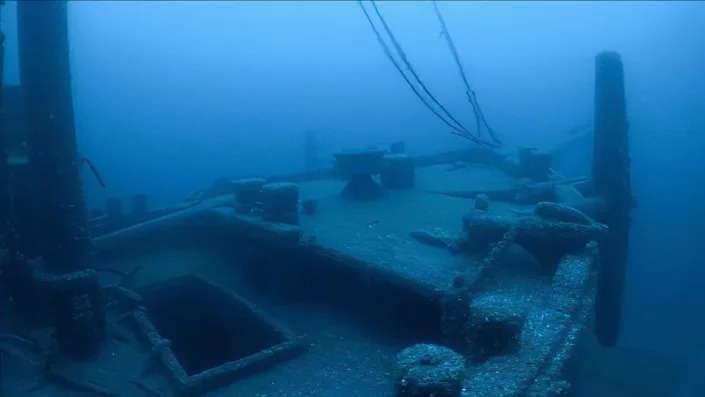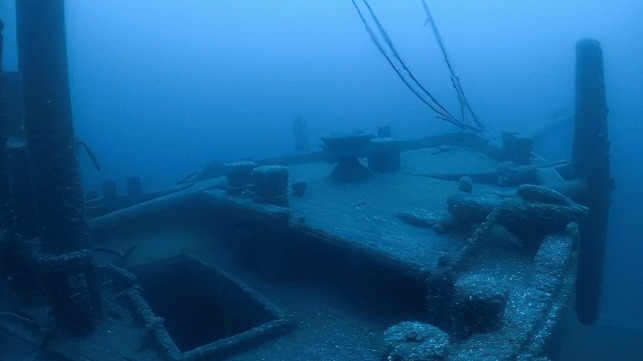Kevin Hurler
Fri, March 3, 2023

A sonar image of the Ironton sitting upright, with all three masts intact, on the bottom of Lake Huron.
Researchers with the National Oceanographic and Atmospheric Administration, the state of Michigan, and Ocean Exploration Trust have found a long-lost sailing ship called Ironton resting upright at the bottom of Lake Huron.
As the 191-foot-long (58-meter) Ironton sailed across the inky black water of Lake Huron in the early hours of a September 1894 morning, it collided with a freight ship called Ohio. Ironton sank, with only two of its seven crew surviving to tell the tale, and no one saw it again for over a century. This week, NOAA announced that the Ironton was found using sonar imaging in 2019. Researchers located the ship hundreds of feet below the surface, sitting upright on the lakebed, with its three masts and rigging appearing relatively undamaged.
“The discovery illustrates how we can use the past to create a better future,” said Jeff Gray, Thunder Bay National Marine Sanctuary superintendent, in a NOAA press release. “Using this cutting-edge technology, we have not only located a pristine shipwreck lost for over a century, we are also learning more about one of our nation’s most important natural resources—the Great Lakes. This research will help protect Lake Huron and its rich history.”

Ironton sitting at the bottom of Lake Huron.
According to NOAA, Ironton was traveling with the Moonlight, both in tow behind the Kershaw as all three departed Ashtabula, Ohio en route to Marquette, Michigan. At 12:30 a.m. on September 26, 1894, the lead vessel’s engine failed while a strong wind pushed Moonlight and Ironton toward the crippled ship. Crew aboard Moonlight severed the line holding Ironton to Kershaw, and Ironton drifted away into the dark of the night.
At the mercy of Lake Huron’s winds, Ironton veered from its course and collided with Ohio, a steamship that was carrying 1,000 tons of grain to Ogdensburg, New York from Duluth, Minnesota. Ironton’s bow ripped a 12-foot (3.6-meter) hole in Ohio’s hull, and Ironton drifted for an hour before sinking beneath the waves.

The departure and arrival point for the Kershaw, Moonlight, and Ironton (blue circles) and the Ohio (red triangles).
Researchers from NOAA’s Thunder Bay National Marine Sanctuary began looking for both Ohio and Ironton in 2017, and found Ohio submerged under 300 feet (91 meters of water). In 2019, NOAA partnered with Robert Ballard’s Ocean Exploration Trust to find Ironton using a piece of technology called BEN, or “Bathymetric Explorer and Navigator,” which is a self-driving boat that can use sonar to map a lakebed.
Using sonar imaging and knowledge of the location of Ohio—along with historic wind and weather data from the time of the collision—the team of researchers soon found a ship. After observing the wreck with a submersible, they confirmed the wreck was the Ironton. NOAA says that Thunder Bay National Sanctuary is planning to create educational materials and exhibits based on the Ironton. Divers can also visit the site of the wreck.
“The discovery of Ironton inspires us to keep exploring,” said Gray. “We will continue to map Thunder Bay National Marine Sanctuary, and this research will ultimately lead to even more discoveries about the Great Lakes and the unique collection of shipwrecks that rest on the lakebed.”
NOAA Finds Wreck of Great Lakes Schooner in Perfect Shape

A public-private research team has located an exceptional and rare find on the bottom of Lake Huron: the wreck of a 190-foot sailing vessel with all three of its original masts still upright and standing. The vessel, identified as the 19th-century schooner barge Ironton, was found within the boundaries of the Thunder Bay National Marine Sanctuary in 2019, and its discovery was first announced on Wednesday.
Ironton was a 1,250 dwt "consort" barge built in 1873. She was part of the great fleet of crewed cargo barges that were constructed to augment the capacity of merchant steamers on the Great Lakes towards the end of the 19th century. She could sail independently if needed, but her primary function was to operate under tow.
In September 1894, Ironton departed Ashtabula, Ohio under tow by the steamer Charles J. Kershaw. She was at the far end of the tow arrangement, behind the barge Moonlight. In the early hours of September 26, as they crossed Lake Huron, the Kershaw lost power in rough weather. The wind blew Ironton towards Moonlight and Kershaw, and the crew of the Moonlight cut Ironton's tow line loose to prevent a collision.
This left Ironton adrift in foul weather. The captain ordered the crew to raise the sails so that they could regain control of their heading, but their efforts were not quick enough. Ironton drifted across the bow of an oncoming steamer, the Ohio, and collided with her port quarter. The impact holed both vessels' hulls, and Ohio sank quickly.
Ironton drifted for another hour before she slipped below. The crew managed to board their lifeboat, but in the rush to abandon ship, the painter remained tied to the stern. Ironton pulled the boat down with her as she sank, claiming the lives of five crewmembers. Two men survived by clinging to wreckage and were picked up by a passing steamer.
In 2017, a NOAA survey of 100 square miles of the Thunder Bay National Marine Sanctuary identified the site of the Ohio's wreck. The research team knew that Ironton must be nearby, but the sonar data did not yield any further clues to her location.
In 2019, a joint team from NOAA and Robert Ballard's Ocean Exploration Trust returned to the area. Using advanced calculations to extrapolate from the Ironton's last known position, they determined the likeliest area for her final resting place. Based on this intelligence, they mapped the target area using an autonomous workboat equipped with sidescan sonar. An object matching Ironton appeared near the end of the search expedition, and an ROV inspection confirmed the find the next month.
A second expedition in June 2021 drew on the resources of the U.S. Coast Guard and the University of North Carolina's Undersea Vehicle Program to conduct a more thorough ROV survey. The team found that the Ironton was in remarkably good condition in the cold, deep water of Lake Huron. She sat on an even keel on the bottom, with all three masts upright and rigging attached as though still preparing to set sail.
The survey also confirmed the survivors' tale of human error and disaster: After 120 years, Ironton's lifeboat was still lashed to the stern.
"The discovery illustrates how we can use the past to create a better future," said Jeff Gray, Thunder Bay National Marine Sanctuary superintendent. "Using this cutting-edge technology, we have not only located a pristine shipwreck lost for over a century, we are also learning more about one of our nation's most important natural resources—the Great Lakes. This research will help protect Lake Huron and its rich history."
The researchers intend to continue mapping the Thunder Bay National Marine Sanctuary in search of more discoveries about the area's 200-plus shipwrecks.
No comments:
Post a Comment